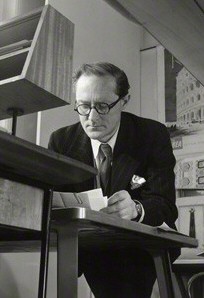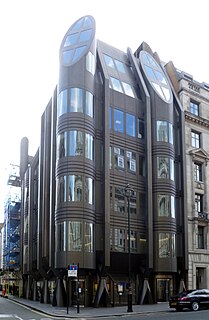
Sir Denys Louis Lasdun, CH, CBE was an eminent English architect, the son of Nathan Lasdun (1879–1920) and Julie. Probably his best known work is the Royal National Theatre, on London's South Bank of the Thames, which is a Grade II* listed building and one of the most notable examples of Brutalist design in the United Kingdom.

Sir Hugh Maxwell Casson was an English architect, interior designer, artist, and writer and broadcaster on 20th-century design. He was the director of architecture at the 1951 Festival of Britain on London's South Bank.

Donald Hanks McMorran RA was an English architect who is known today for his sensitive continuation of the neo-Georgian and classical tradition in the period after the Second World War. His buildings include halls of residence at the University of Nottingham, Wood Street Police Station in the City of London, public housing schemes around London, the South Block extension to the Old Bailey and civic buildings in Exeter and Bury St Edmunds. McMorran was a Master of the Art Workers Guild in 1956 and was elected to the Royal Academy in 1962. His work is characterised by carefully chosen materials, well-detailed and handsomely proportioned facades with minimal classical detail, showing the influence in particular of the work of John Soane. There is also a strong sense of aesthetic opposition to the bulk of the Modern Movement work of the same period. McMorran was, however, not narrow-minded in his attitude to the Modern Movement, and as assessor in the City of London's Golden Lane housing competition he awarded first place to the young Modernists, Chamberlin, Powell and Bon.
Edward Horder Cullinan CBE, RA, RIBA, HonFRIAS, better known as Ted Cullinan, is an English architect.

The Golden Lane Estate is a notable 1950s council housing complex in the City of London. It was built on the northern edge of the City, in an area devastated by bombing during World War II.

Eric Alfred Lyons CBE (1912–1980) was a British designer and architect. He achieved critical recognition in his development of family and technology-embracing housing communities in England in the latter part of the 20th century. His partnership in Span Developments led to the building of over 73 estates, some of which have achieved Conservation area status in recognition of the close communities created with substantial garden areas, glass and light, façade angles used for privacy and decoration and separate garages as a practical Bauhaus for car-based culture and high point of Modern Architecture widely described a "successful, experimental modernism".
John Bradshaw Gass was an English architect and artist.
Lionel Bailey Budden FRIBA was an English architect.
Ian Ritchie is a British architect, artist and author, who founded Ian Ritchie Architects in 1981. His projects include the RIBA Award-winning Susie Sainsbury Theatre and Angela Burgess Recital Hall for the Royal Academy of Music, Sainsbury Wellcome Centre for Neural Circuits and Behaviour, University College London, and the American Institute of Architects Award-winning Royal Shakespeare Company Courtyard Theatre. Ritchie was the first foreign architect to receive the French Academie d’Architecture Grand Silver Medal for Innovation.
John Alfred Gotch was a noted English architect and architectural historian. His brother was the Pre-Raphaelite painter and illustrator Thomas Cooper Gotch, who painted his portrait.

Rodney H Gordon was an English architect. He was the primary architect of the Tricorn Centre, Portsmouth, and Trinity Square, Gateshead. Architecturally, his works were primarily in concrete; he was said to be a Brutalist and his buildings have been described as "dramatic, sculptural and enormous" as well as "futuristic".

The Barbican Centre is a performing arts centre in the Barbican Estate of the City of London and the largest of its kind in Europe. The Centre hosts classical and contemporary music concerts, theatre performances, film screenings and art exhibitions. It also houses a library, three restaurants, and a conservatory. The Barbican Centre is member of the Global Cultural Districts Network.

Mabel Scott Lauder Pryde was an artist, and wife of artist William Nicholson and mother of artists Ben Nicholson and Nancy Nicholson and the architect Christopher 'Kit' Nicholson.
Leonard Rome Guthrie was an English architect. He joined the Wimperis & Simpson partnership in 1925 to form Wimperis, Simpson and Guthrie.
Michael Manser was a British architect. He was a president of the Royal Institute of British Architects (RIBA) and established his own successful architecture practice in 1961.
Hugh Roumieu Gough was an English architect.
Patricia Ann Hopkins, Lady Hopkins is an English architect and joint winner, along with her husband Sir Michael Hopkins, of the 1994 Royal Gold Medal for Architecture.
Hugh Giles Keyworth Broughton is an English architect and one of the world's leading designers of polar research facilities. His practice, Hugh Broughton Architects, was founded in 1995 and is based in London, works internationally. The practice has won several high profile international design competitions, including Halley VI Research Station, Juan Carlos 1 Spanish Antarctic Base, the Atmospheric Watch Observatory in Greenland for the US National Science Foundation and a new health facility on Tristan da Cunha, the world's most remote inhabited island. The practice has received numerous international awards including a RIBA National Award 2016, The American Prize for Architecture 2016, Civic Trust Award Special Award for Sustainability 2014, RIBA International Award 2013, three AJ Retrofit Awards in 2013, and BD International Breakthrough Architect of the Year Award 2012
















